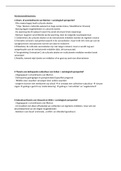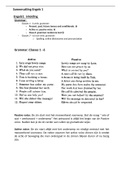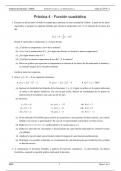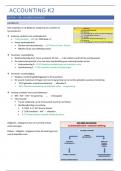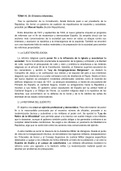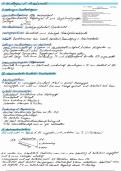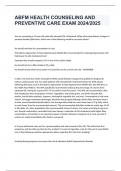Achterstandstheorieën:
1 Strain- of anomietheorie van Merton = sociologisch perspectief
- Elke maatschappij heeft culturele doelen
* (bijv. Westen: materiële welvaart en hoge sociale status / Boeddhisme: Nirvana)
- Botsing legale mogelijkheden en culturele doelen
- De spanning die dit oplevert noemt hij social structural strain (spanning)
- Mensen reageren verschillende op die spanning, door de volgende reactiepatronen:
1 Conformiteit; de culturele doelen en de institutionele middelen worden als legitiem ervaren
2 Innovatie; iemand is wel geïnteresseerd in de succesdoelen, maar trekt zich niets aan van de
voorgeschreven institutionele normen om deze te realiseren
3 Ritualisme; de culturele succesdoelen zijn niet langer relevant, maar er wordt nog wel
vastgehouden aan de institutionele middelen (bijv. de bureaucraat)
4 Terugtrekking (‘retreatism’); de culturele doelen en institutionele middelen worden beide
verworpen
5 Rebellie; iemand wijst doelen en middelen af en gaat op zoek naar alternatieven
2 Theorie van delinquente subcultuur van Cohen = sociologisch perspectief
- Uitgangspunt is straintheorie van Merton
- Delinquente gedragingen in groepsverband (specifiek jongeren)
- ‘Middle-class’ waarden vervangen door andere waarden
- Jongeren kunnen niet meekomen op school → er ontstaat een collectieve subcultuur → nieuwe
regels → gedrag is gericht op ‘snelle beloning’ → gedrag is ‘niet-utilitair’ en ‘negativistisch’
3 Subcultuurtheorie van Cloward en Ohlin = sociologisch perspectief
- Uitgangspunt is straintheorie van Merton
- Criminaliteit niet alleen afhankelijk van ontbreken van legitieme middelen, maar ook van
beschikbaarheid van de illegale mogelijkheden
- Relaties in een buurt (criminele-, conflict- en afzonderingscultuur)
, Sociale-desorganisatietheorieën + oorzaaktheorieën (= waarom wel):
4 Chicago School van Shaw & McKay = sociologisch perspectief
- Statistici constateren verschillen per wijk
* kenmerken wijk beïnvloeden verdeling criminaliteit
- Armoede en criminaliteit gevolg industriële revolutie
- Explosieve stedelijke expansie
- Uitgangspunt biologie
* planten en dieren passen zich aan hun omgeving aan
- Patroon van concentrische cirkels
- Meeste criminele buurten; liggen tegen de industriële zone aan (2e cirkel), buurten met laagste soc.
economische status, buurten met lage sociale cohesie, buurten met hoge sociale ontwrichting
- Hoogste criminaliteitscijfers in buurten met migranten
- Onafhankelijk van welke migrantengroepen er wonen
5 Broken windows theorie van Wilson & Kelling = sociologisch perspectief
- Wijken met zichtbare verloedering
- Signaal van ontbreken sociale controle
- Voor daders vrijbrief voor criminaliteit
- Voor slachtoffers teken van gevaar
Beheersingstheorie (= waarom niet):
6 Bindingentheorie (=sociale controle theorie) van Hirschi = sociologisch perspectief
- ’Criminologie zou niet moeten verklaren waarom sommige mensen delicten plegen, maar waarom
zovelen het laten!’
- Sociaal aangepast gedrag
* is gevolg van bindingen van individuen met hun omgeving
- Mens is hedonistisch = eigen belang/genot voorop
- Goede socialisatie beheerst hedonisme
- Socialisatie zorgt voor binding met maatschappij
- Vier vormen van binding:
1 Gehechtheid/attachment; heeft betrekking op de emotionele gehechtheid aan andere personen,
met name de relatie met ouders
2 Betrokkenheid/commitment; heeft betrekking op zelf aangegane verplichtingen, delinquent gedrag
brengt kosten met zich mee (kosten vs. baten)
3 Gebondenheid/involvement; iemand heeft allerlei conventionele bezigheden, daardoor geen tijd
voor criminaliteit
4 Normen en waarden/beliefs; aanvaarding van de maatschappelijke regels, intrinsiek respect voor
de wet
1 Strain- of anomietheorie van Merton = sociologisch perspectief
- Elke maatschappij heeft culturele doelen
* (bijv. Westen: materiële welvaart en hoge sociale status / Boeddhisme: Nirvana)
- Botsing legale mogelijkheden en culturele doelen
- De spanning die dit oplevert noemt hij social structural strain (spanning)
- Mensen reageren verschillende op die spanning, door de volgende reactiepatronen:
1 Conformiteit; de culturele doelen en de institutionele middelen worden als legitiem ervaren
2 Innovatie; iemand is wel geïnteresseerd in de succesdoelen, maar trekt zich niets aan van de
voorgeschreven institutionele normen om deze te realiseren
3 Ritualisme; de culturele succesdoelen zijn niet langer relevant, maar er wordt nog wel
vastgehouden aan de institutionele middelen (bijv. de bureaucraat)
4 Terugtrekking (‘retreatism’); de culturele doelen en institutionele middelen worden beide
verworpen
5 Rebellie; iemand wijst doelen en middelen af en gaat op zoek naar alternatieven
2 Theorie van delinquente subcultuur van Cohen = sociologisch perspectief
- Uitgangspunt is straintheorie van Merton
- Delinquente gedragingen in groepsverband (specifiek jongeren)
- ‘Middle-class’ waarden vervangen door andere waarden
- Jongeren kunnen niet meekomen op school → er ontstaat een collectieve subcultuur → nieuwe
regels → gedrag is gericht op ‘snelle beloning’ → gedrag is ‘niet-utilitair’ en ‘negativistisch’
3 Subcultuurtheorie van Cloward en Ohlin = sociologisch perspectief
- Uitgangspunt is straintheorie van Merton
- Criminaliteit niet alleen afhankelijk van ontbreken van legitieme middelen, maar ook van
beschikbaarheid van de illegale mogelijkheden
- Relaties in een buurt (criminele-, conflict- en afzonderingscultuur)
, Sociale-desorganisatietheorieën + oorzaaktheorieën (= waarom wel):
4 Chicago School van Shaw & McKay = sociologisch perspectief
- Statistici constateren verschillen per wijk
* kenmerken wijk beïnvloeden verdeling criminaliteit
- Armoede en criminaliteit gevolg industriële revolutie
- Explosieve stedelijke expansie
- Uitgangspunt biologie
* planten en dieren passen zich aan hun omgeving aan
- Patroon van concentrische cirkels
- Meeste criminele buurten; liggen tegen de industriële zone aan (2e cirkel), buurten met laagste soc.
economische status, buurten met lage sociale cohesie, buurten met hoge sociale ontwrichting
- Hoogste criminaliteitscijfers in buurten met migranten
- Onafhankelijk van welke migrantengroepen er wonen
5 Broken windows theorie van Wilson & Kelling = sociologisch perspectief
- Wijken met zichtbare verloedering
- Signaal van ontbreken sociale controle
- Voor daders vrijbrief voor criminaliteit
- Voor slachtoffers teken van gevaar
Beheersingstheorie (= waarom niet):
6 Bindingentheorie (=sociale controle theorie) van Hirschi = sociologisch perspectief
- ’Criminologie zou niet moeten verklaren waarom sommige mensen delicten plegen, maar waarom
zovelen het laten!’
- Sociaal aangepast gedrag
* is gevolg van bindingen van individuen met hun omgeving
- Mens is hedonistisch = eigen belang/genot voorop
- Goede socialisatie beheerst hedonisme
- Socialisatie zorgt voor binding met maatschappij
- Vier vormen van binding:
1 Gehechtheid/attachment; heeft betrekking op de emotionele gehechtheid aan andere personen,
met name de relatie met ouders
2 Betrokkenheid/commitment; heeft betrekking op zelf aangegane verplichtingen, delinquent gedrag
brengt kosten met zich mee (kosten vs. baten)
3 Gebondenheid/involvement; iemand heeft allerlei conventionele bezigheden, daardoor geen tijd
voor criminaliteit
4 Normen en waarden/beliefs; aanvaarding van de maatschappelijke regels, intrinsiek respect voor
de wet

